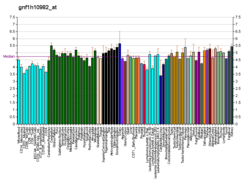ATG16L1
Autophagy-related protein 16-1 is a protein that in humans is encoded by the ATG16L1 gene.[5]
Function
Autophagy is the major intracellular degradation system delivering cytoplasmic components to lysosomes, and it accounts for degradation of most long-lived proteins and some organelles. Cytoplasmic constituents, including organelles, are sequestered into double-membraned autophagosomes, which subsequently fuse with lysosomes. ATG16L1 is a component of a large protein complex essential for autophagy.[6][7]
Clinical significance
Mutations in the ATG16L1 gene may be linked to Crohn's disease.[8][9][10]
References
- 1 2 3 ENSG00000085978 GRCh38: Ensembl release 89: ENSG00000281089, ENSG00000085978 - Ensembl, May 2017
- 1 2 3 GRCm38: Ensembl release 89: ENSMUSG00000026289 - Ensembl, May 2017
- ↑ "Human PubMed Reference:".
- ↑ "Mouse PubMed Reference:".
- ↑ Zheng H, Ji C, Li J, Jiang H, Ren M, Lu Q, Gu S, Mao Y, Xie Y (August 2004). "Cloning and analysis of human Apg16L". DNA Sequence. 15 (4): 303–5. doi:10.1080/10425170400004104. PMID 15620219.
- ↑ Mizushima N, Kuma A, Kobayashi Y, Yamamoto A, Matsubae M, Takao T, Natsume T, Ohsumi Y, Yoshimori T (May 2003). "Mouse Apg16L, a novel WD-repeat protein, targets to the autophagic isolation membrane with the Apg12-Apg5 conjugate". Journal of Cell Science. 116 (Pt 9): 1679–88. doi:10.1242/jcs.00381. PMID 12665549.
- ↑ "Entrez Gene: ATG16L1 ATG16 autophagy related 16-like 1 (S. cerevisiae)".
- ↑ Hampe J, Franke A, Rosenstiel P, Till A, Teuber M, Huse K, Albrecht M, Mayr G, De La Vega FM, Briggs J, Günther S, Prescott NJ, Onnie CM, Häsler R, Sipos B, Fölsch UR, Lengauer T, Platzer M, Mathew CG, Krawczak M, Schreiber S (February 2007). "A genome-wide association scan of nonsynonymous SNPs identifies a susceptibility variant for Crohn disease in ATG16L1". Nature Genetics. 39 (2): 207–11. doi:10.1038/ng1954. PMID 17200669.
- ↑ Rioux JRioux JD, Xavier RJ, Taylor KD, Silverberg MS, Goyette P, Huett A, Green T, Kuballa P, Barmada MM, Datta LW, Shugart YY, Griffiths AM, Targan SR, Ippoliti AF, Bernard EJ, Mei L, Nicolae DL, Regueiro M, Schumm LP, Steinhart AH, Rotter JI, Duerr RH, Cho JH, Daly MJ, Brant SR (May 2007). "Genome-wide association study identifies five novel susceptibility loci for Crohn's disease and implicates a role for autophagy in disease pathogenesis". Nature Genetics. 39 (5): 596–604. doi:10.1038/ng2032. PMC 2757939. PMID 17435756.
- ↑ Burton, Paul R.; Clayton, David G.; Cardon, Lon R.; Craddock, Nick; Deloukas, Panos; Duncanson, Audrey; Kwiatkowski, Dominic P.; McCarthy, Mark I.; et al. (June 2007). "Genome-wide association study of 14,000 cases of seven common diseases and 3,000 shared controls". Nature. 447 (7145): 661–78. doi:10.1038/nature05911. PMC 2719288. PMID 17554300.
External links
- Human ATG16L1 genome location and ATG16L1 gene details page in the UCSC Genome Browser.
Further reading
- Venter JC, Adams MD, Myers EW, et al. (2001). "The sequence of the human genome". Science. 291 (5507): 1304–51. doi:10.1126/science.1058040. PMID 11181995.
- Strausberg RL, Feingold EA, Grouse LH, et al. (2003). "Generation and initial analysis of more than 15,000 full-length human and mouse cDNA sequences". Proc. Natl. Acad. Sci. U.S.A. 99 (26): 16899–903. doi:10.1073/pnas.242603899. PMC 139241. PMID 12477932.
- Mizushima N, Kuma A, Kobayashi Y, et al. (2004). "Mouse Apg16L, a novel WD-repeat protein, targets to the autophagic isolation membrane with the Apg12-Apg5 conjugate". J. Cell Sci. 116 (Pt 9): 1679–88. doi:10.1242/jcs.00381. PMID 12665549.
- Clark HF, Gurney AL, Abaya E, et al. (2003). "The Secreted Protein Discovery Initiative (SPDI), a Large-Scale Effort to Identify Novel Human Secreted and Transmembrane Proteins: A Bioinformatics Assessment". Genome Res. 13 (10): 2265–70. doi:10.1101/gr.1293003. PMC 403697. PMID 12975309.
- Ota T, Suzuki Y, Nishikawa T, et al. (2004). "Complete sequencing and characterization of 21,243 full-length human cDNAs". Nat. Genet. 36 (1): 40–5. doi:10.1038/ng1285. PMID 14702039.
- Bouwmeester T, Bauch A, Ruffner H, et al. (2004). "A physical and functional map of the human TNF-alpha/NF-kappa B signal transduction pathway". Nat. Cell Biol. 6 (2): 97–105. doi:10.1038/ncb1086. PMID 14743216.
- Gerhard DS, Wagner L, Feingold EA, et al. (2004). "The Status, Quality, and Expansion of the NIH Full-Length cDNA Project: The Mammalian Gene Collection (MGC)". Genome Res. 14 (10B): 2121–7. doi:10.1101/gr.2596504. PMC 528928. PMID 15489334.
- Zheng H, Ji C, Li J, et al. (2005). "Cloning and analysis of human Apg16L". DNA Seq. 15 (4): 303–5. doi:10.1080/10425170400004104. PMID 15620219.
- Kimura K, Wakamatsu A, Suzuki Y, et al. (2006). "Diversification of transcriptional modulation: Large-scale identification and characterization of putative alternative promoters of human genes". Genome Res. 16 (1): 55–65. doi:10.1101/gr.4039406. PMC 1356129. PMID 16344560.
- Hampe J, Franke A, Rosenstiel P, et al. (2007). "A genome-wide association scan of nonsynonymous SNPs identifies a susceptibility variant for Crohn disease in ATG16L1". Nat. Genet. 39 (2): 207–11. doi:10.1038/ng1954. PMID 17200669.
- Ewing RM, Chu P, Elisma F, et al. (2007). "Large-scale mapping of human protein–protein interactions by mass spectrometry". Mol. Syst. Biol. 3 (1): 89. doi:10.1038/msb4100134. PMC 1847948. PMID 17353931.
- Prescott NJ, Fisher SA, Franke A, et al. (2007). "A nonsynonymous SNP in ATG16L1 predisposes to ileal Crohn's disease and is independent of CARD15 and IBD5". Gastroenterology. 132 (5): 1665–71. doi:10.1053/j.gastro.2007.03.034. PMID 17484864.
- Yamazaki K, Onouchi Y, Takazoe M, et al. (2007). "Association analysis of genetic variants in IL23R, ATG16L1 and 5p13.1 loci with Crohn's disease in Japanese patients". J. Hum. Genet. 52 (7): 575–83. doi:10.1007/s10038-007-0156-z. PMID 17534574.
- Baldassano RN, Bradfield JP, Monos DS, et al. (2007). "Association of the T300A non‐synonymous variant of the ATG16L1 gene with susceptibility to paediatric Crohn's disease". Gut. 56 (8): 1171–3. doi:10.1136/gut.2007.122747. PMC 1955510. PMID 17625155.
This article incorporates text from the United States National Library of Medicine, which is in the public domain.
This article is issued from
Wikipedia.
The text is licensed under Creative Commons - Attribution - Sharealike.
Additional terms may apply for the media files.






